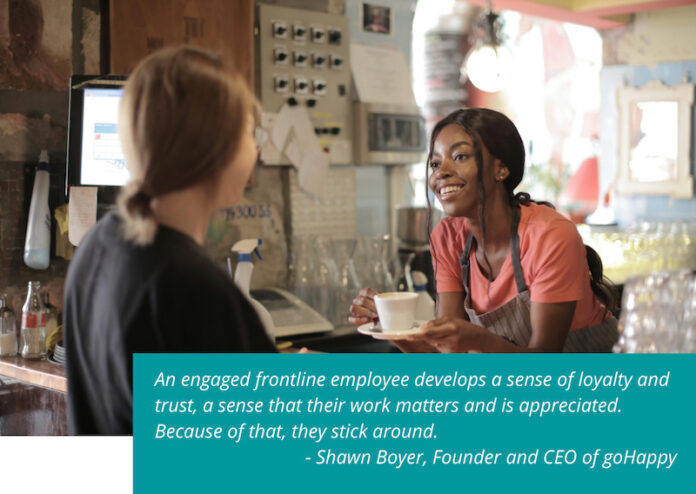By Shawn Boyer
When was the last time you had a new frontline employee start, and everyone on the team already knew their name and welcomed them as soon as they walked through the door their first day?
Or when you were able to properly celebrate each of your frontline employees’ work anniversaries because you had a reminder text that it was going to be their anniversary two days in advance? Do you have automated ways to do a quick pulse check on how your new hires are doing seven days or 30 days in? Do you have an easy way to recognize one of your team members for living out your values in front of all of your employees vs. just the ones that are there for a pre-shift meeting?
Another way of asking those questions is: Do you have systems set up that help you show your frontline employees just how much you value them so that they feel appreciated and emotionally connected to you and the company (aka, feeling engaged!)?
At a time when staffing shortages continue to wreak havoc on many businesses – not to mention the additional stress the latest variant of COVID-19 has put on our teams – creating or enhancing engagement within your organization is an essential factor in retaining the employees you have.
As difficult as the pandemic has been for businesses to keep their employees from looking elsewhere for employment, it’s become increasingly important for businesses to home in on their frontline employees.
Easier said than done, right?
With about 11 million job openings that more and more often include signing perks, it’s harder than ever to retain those on the front line. Making things worse is that we’re still down about 4 million workers from where we were before the pandemic, and 4.3 million Americans quit their jobs in December, often transitioning to a new opportunity. Some simple math: more openings + fewer workers = higher stress on retention.
According to a U.S. Chamber of Commerce report in February, industries like leisure, hospitality, retail and healthcare have seen higher percentages of frontline employees leaving their jobs, with durable goods/manufacturing and leisure/hospitality facing the biggest shortages.
Since about 90% of businesses employ frontline workers, it’s vital to redouble efforts on this invaluable asset.
This is where engagement comes in.
Are you not entertained, er, engaged?
Gallup announced in January that for the first year in more than a decade, employee engagement dropped in 2021. The first time in more than 10 years! It reported that 34% of Americans were engaged, and 16% were actively disengaged, down from 36% and 14% in 2020.
We’ve all seen first-hand the issues many businesses are having, despite unemployment checking in at 4.0% in the February jobs report. In many cases, restaurants and retailers – even big ones like Walmart – continue to curtail hours or temporarily close. The Wall Street Journal highlighted a hospitality company that needed to fly its housekeepers from various locations across the country to cover staffing issues. In September, the Associated General Contractors of America revealed that 89% of construction firms are struggling to fill craft positions and 86% skilled salaried positions.
Clearly, the pandemic has had an effect on worker engagement. But it also has provided an opportunity.
The value of engaged frontline employees
There are plenty of definitions for engaged worker, but after 20 years of assisting and studying employers and employees, I’ve found this description sums it up best: Engagement is a heightened emotional connection that an employee feels for his or her organization that influences him or her to be more committed and to exert greater discretionary effort to his or her work.
An engaged employee feels valued. An engaged employee feels connected. An engaged employee has a heightened emotional connection to work.
These employees are more productive and less likely to miss work or leave their job. In addition, they often serve as valuable recruiters – employers can tap into happy employees for referrals, a strategy that easily can be employed during these wild times.
What all this leads to is loyalty. An engaged frontline employee develops a sense of loyalty and trust, a sense that their work matters and is appreciated. Because of that, they stick around.
And for our colleagues who are on the front line – the ones who often are interacting most with the people who make or break our bottom line – isn’t this what we want? Someone who feels empowered to do their job, knowing they are supported and a key ingredient to the larger success of the operation?
Unengaged frontline employees leave, especially in today’s job market.
In normal times, studies have shown that replacing an employee who leaves can cost up to a third of their annual earnings. SHRM estimated in 2019 that 67% of that replacement cost came from reduced productivity and 33% from recruiting, onboarding and training, among other hard costs.
Engaging your frontline team
Building an engaging relationship with your team starts from Day 1. Some might say that because of the staffing environment we’re in, the first 30, 60 to 90 days are more important than ever in making a lasting impression and hopefully reducing turnover. But, enhancing company relationships spans the rookies to veterans.
During both my time leading Snagajob, the nation’s largest marketplace for hourly workers and employers, and here at goHappy, the common denominator for our customers who have the highest engagement levels among their frontline employees, is that they make their company culture one of their top strategic priorities. Sure, it takes time and resources, but they know that the investment makes such a difference to their bottom line.
Here are just a few things those companies do that you might want to consider for engaging your new frontline workers:
- Share the name and picture of a new employee before their first day so everyone on your team can welcome them.
- Assign a work “buddy” to show them the ropes in addition to their manager or trainer.
- Seven days in, send the new employee an onboarding survey to see how they’re doing. Consider doing this again after 30 or 60 days.
For your veteran frontline employees, the companies we work with that have the highest levels of engagement do a variety of things:
- Show gratitude by giving shout-outs to employees in pre-shift meetings and through your messaging platforms.
- Encourage employees to give shout-outs to each other in the same way.
- Introduce “living the values” competitions each month, and recognize an employee who embodies your company’s spirit.
- Improve the ease in which employees can communicate back to leadership.
- Request fun things, like pictures for a Pet of the Week contest or recipe ideas.
A few final thoughts
We’re all busy. But, engaging your frontline has to be a priority. It has to be intentional. In order to do that, you need a process for it and ideally a platform that makes it much easier for you to show how much you do value them. Because when you do, your frontline team members will feel that heightened emotional connection. They will be more engaged, which means they’ll perform at such a higher level. And, it will make it a heck of a lot less likely that they’ll even think of leaving.
Download the white paper, “Employee Communications Best Practices.”

